When purchasing plants, you generally have two options: buy a mature plant or buy some seeds.
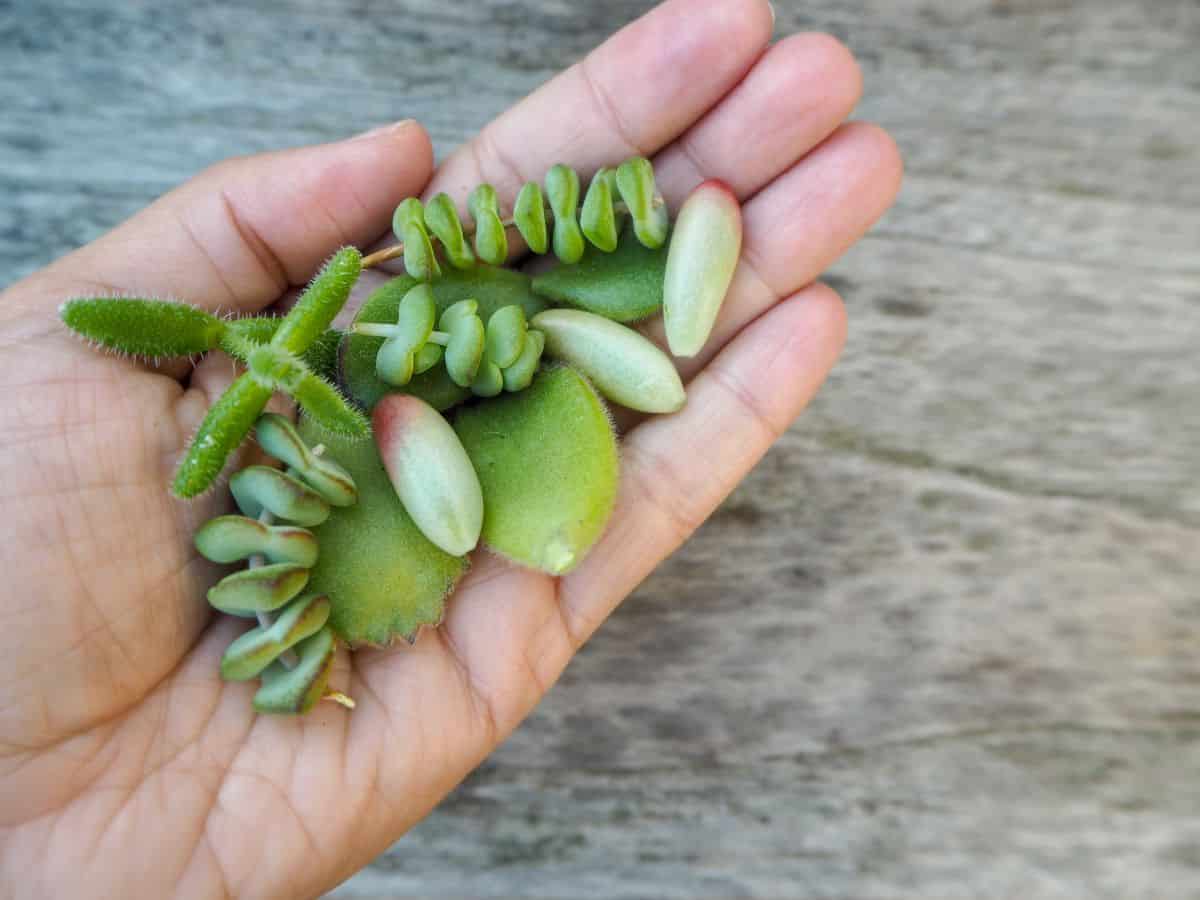
Succulents and cacti, however, have a third option: shop around for cuttings.
If you're new to the hobby, or just new to fat plants, it's common to have some confusion and more than a few questions. "Why would I want to buy a leaf?" "What's a cactus pad good for?" "You're telling me I don't have to water anything??"
So here's a primer for ya. Read on to find out how to get new plants from just a couple cuttings or leaves.
Jump to:
- Succulent and Cacti Cuttings and Leaves
- When Should I Choose Cuttings and Leaves over Seeds or Mature Plants?
- So when IS a good time to choose cuttings?
- How to Pluck a Succulent Leaf Properly
- How to Take a Succulent or Cactus Cutting Correctly
- How to Grow a New Plant From A Leaf or Cutting
- Soil
- Water
- Light
- When to Separate the Baby Succulent from the Mother Leaf
- Where to Find Succulent Leaves and Cuttings
- Where to Buy Succulent Leaves and Cuttings
Succulent and Cacti Cuttings and Leaves
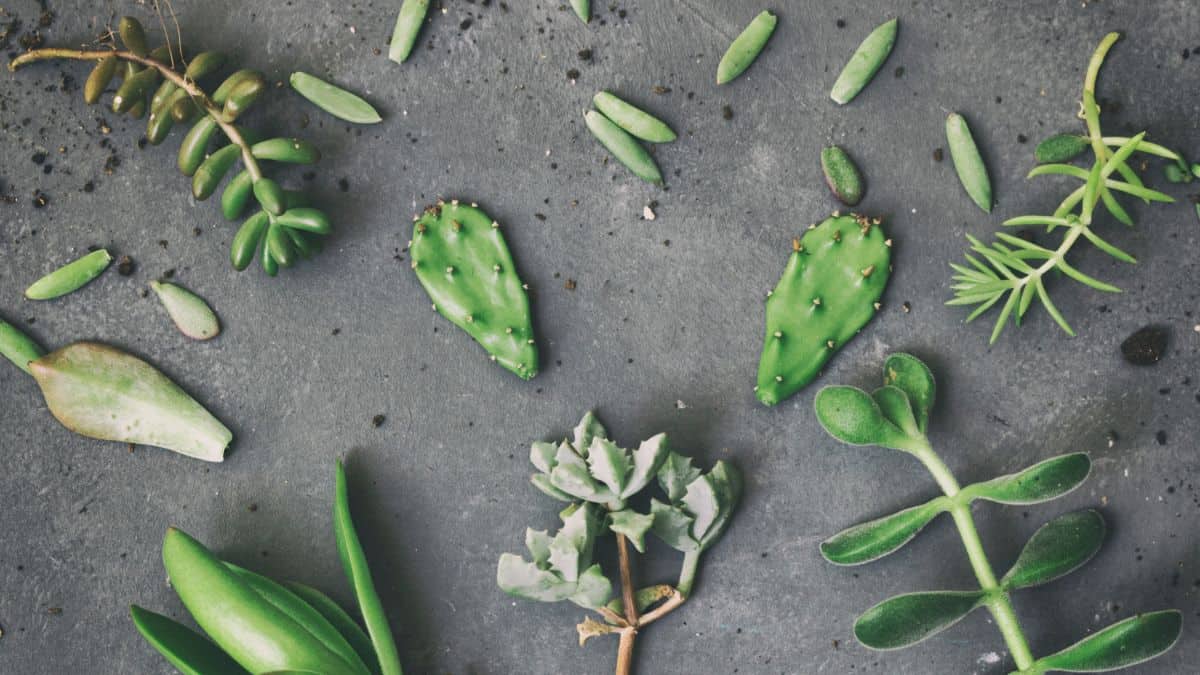
To put it simply - almost every succulent (which includes cacti) is able to propagate from a leaf or a cutting. While the trait is not entirely unique to these xeriphilic (dry-loving) plants, they have perfected it.
It's not unheard of to take a trimming from herbs or a tree and place it in water for a couple weeks. Sometimes roots will form. Then you can plant it - easy and free plants!
Succulents take this to the next level. You can trim off a few inches of stem and some leaves, or just the leaves even, and drop it on some dirt and forget about it.
Come back in a few weeks and you're looking at a new plant!
Heck, sometimes leaves get knocked off and hidden behind pots. I'll find them weeks or months later; those runaways will surprise me with a perfectly healthy mini-plant!
This kind of propagation is a form of cloning - the offspring are genetically identical to the parent. That means it's a good way to get plants that are exactly like their parents. It's particularly useful for multiplying rare cultivars or plants with cool characteristics like variegation.
When Should I Choose Cuttings and Leaves over Seeds or Mature Plants?
While Nature has bestowed this awesome power of self-propagation on succulents, you should know that it is not a guaranteed success.
Even in ideal conditions, leaves and other cuttings (collectively known as props or propagations) don't have a 100% survival rate. Based on personal experience, I've been able to get 80%-90% survival from cuttings I put a lot of effort into.
Although, sometimes it seems that the leaves I don't bother with have better chances. That's succulents for ya.
Anyway, what I'm getting at here is this: it's not the easiest method. The easiest way to get more plants is to simply buy them (as full plants). Adult plants are guaranteed to be alive... and if they're not, you should probably get yours somewhere else.
If you're a beginner - I would suggest avoiding seeds and cuttings for a while. They're a bit harder, and even if you do everything right they still might not work out. We don't want you to be turned off the hobby before you even start!
For the experienced, my advice should sound familiar: don't put all your eggs in one basket. (Don't put all your leaves in one pot?)
Just like stock investing, you should diversify your succulent portfolio. Buy plants, propagate some yourself, try starting some seeds, get a grab bag of cuttings, whatever. Go wild.
So when IS a good time to choose cuttings?
If you already have an established and healthy succulent family, you're ready to take on the responsibility of cuttings.
Since they're a bit like gambling, you shouldn't ever spend a lot of money on cuttings. You also shouldn't purchase them because you NEED some quick plants to pay rent with at the end of the month and you have bills piling up and credit cards that have to--
Oh, wait, we're talking about plants. Right.
Succulents cuttings and leaves are great because they're generally pretty cheap and they usually come in randomized assortments. It's a good way to grab a new variety or two without breaking the bank. You also get cute mini succs for a while!
They grow up so fast. *sniff*
How to Pluck a Succulent Leaf Properly
So now you want to get your own leaves for propagating or selling. Cool, me too.
The technique to separate the leaf from the mother plant is vitally important in creating viable leaves. It's not difficult by any means, just specific.
First, you have to choose a leaf. You want a full-sized, mature, healthy leaf without any blemishes or scarring for the best shot at propagation. You can always find these near the base of the plant. Picking a bottom leaf keeps you from disrupting the nice symmetry and rosettes near the top, too.
No products found.
Now, grasp the leaf firmly by its base, as close to the stem as you can. Wiggle it back and forth, or twist slightly. The strategy will differ from plant to plant but the key thing is this: you need to remove the entire leaf without any breakage.
That means it has to be a clean break - there should be no little chunks or plant matter left on the stem. The leaf should have a small, shallow wound at its base without any jagged edges.
It's imperative that you get a clean break, otherwise your chances of successfully propagating are drastically reduced.
Note: Leaf propagation only works for some species of succulent, usually those with obvious stems or distinct leaves. It's great for Echeveria and Graptopetalum, it is extremely difficult or impossible for plants like Aloe or Haworthia.
And cacti, well, they don't have leaves, do they?
How to Take a Succulent or Cactus Cutting Correctly
Taking a cutting is a method of propagation usually employed on succulents with stems... or those that are so etiolated they grew stems anyway.
Much like plucking a leaf, this method is very simple but it requires precise technique. The trick is making as clean a cut as possible. You need to sever the stem in one smooth motion. Jagged edges make the wound less likely to heal properly, and your cutting is less likely to survive.
To make such an incision, use a very sharp instrument. Whatever general-use scissors you have lying around probably aren't sharp enough. Use garden shears or garden scissors, or a recently sharpened knife, to make the cut.
Trimmings or cuttings don't have to be very long. I usually only remove the last 4-6 inches of a stem, so that it includes the growing end.
After you've made the cut, the next step is to remove any leaves from the bottom inch or two of the stem. That part will go underground eventually, so it doesn't need any leaves.
All this is applicable to cacti too! If it has distinct lobes or pads, make a cut where they join. If the cactus doesn't, cutting off an appendage very cleanly and letting it callus will usually be sufficient to get some propagation going.
How to Grow a New Plant From A Leaf or Cutting
Alright, this is really complicated so listen closely. Here's how you get a whole new plant from a cutting or a leaf:
Soil
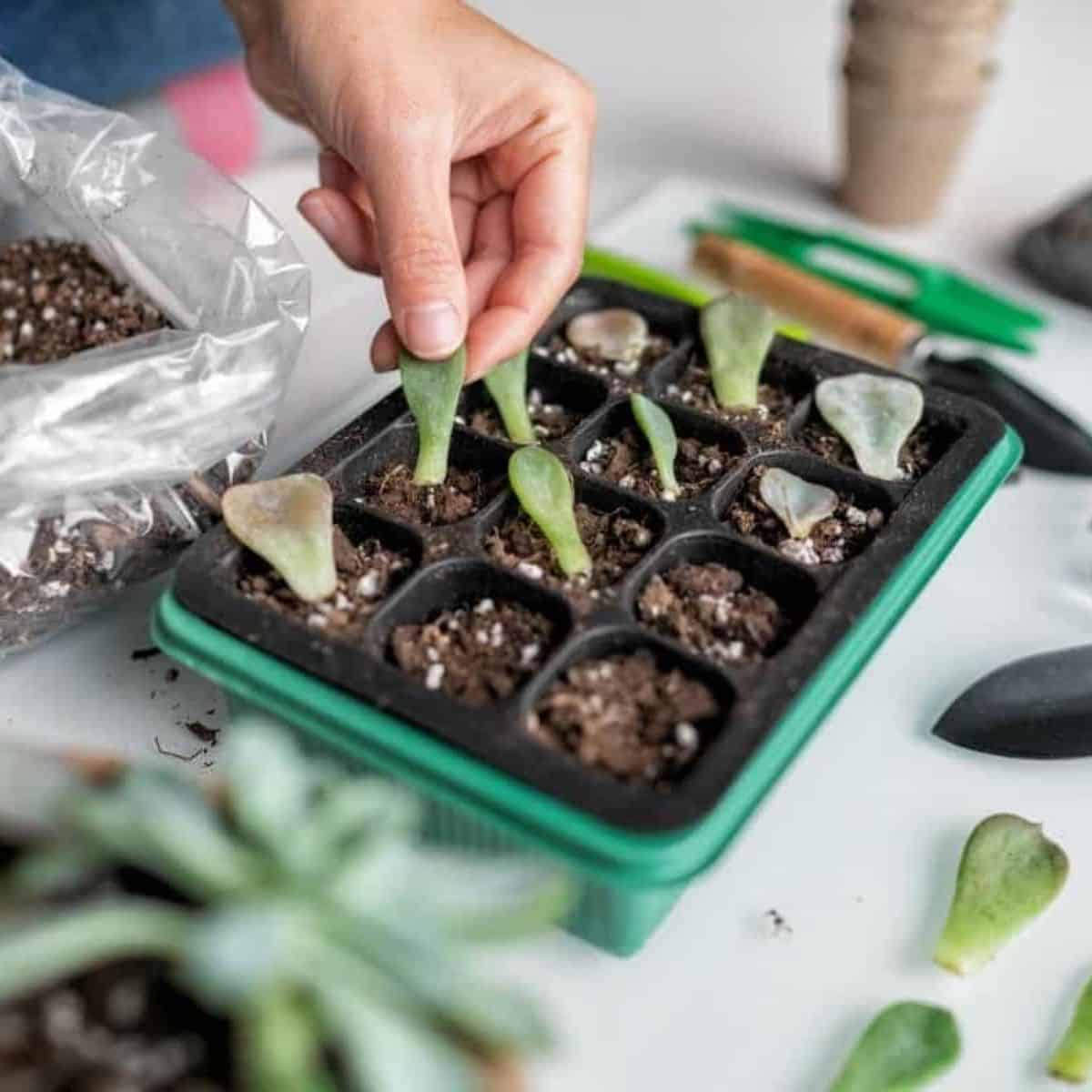
Put it on some dirt and forget about it.
Yes, really, it's that easy. To be honest, it usually happens even if you skip the dirt. Those plants are gonna do their utmost to get growin'. You just need to let it happen.
I'll elaborate. The amount of dirt, or the depth, you use is unimportant. Most of my cuttings are on a plate or tray with less than an inch of dirt on it.
Plants aren't dumb; they can sense all kinds of things like where water is, which way is up and which is down, where nutrients are. They also know if there is soil around. Cuttings and leaves will root more quickly and more robustly in the presence of dirt.
If you have a cutting instead of just a leaf, you might decide to plant it (right side up) in some soil. That's fine too. You won't see the roots growing from the base, but it should happen eventually. Just don't expect for it to continue growing for a bit!
Need help with picking a succulent soil? Here's our take on the best commercially available kinds! Or, if you'd rather make your own - check out this guide.
Water
There is very little need to water your succulent leaves or cuttings. After all, the leaves are full of water. For the most part, they can sustain themselves until they're big enough to be treated like mature plants.
However, if your air is particularly dry, it could dry out the roots as they form on the leaf or cutting. You can mist your propagations lightly with water every couple of days.
Note: Don't allow water anywhere near freshly cut or plucked propagations. It's important that the plant is able to callus, or scab, over the wound first. It can take anywhere from 3 days to a week to callus fully. Exposing them to water beforehand often causes rot.
Light
The best place to put your cutting or leaf is in a space that gets a lot of bright, but indirect, lighting.
Some windows are perfect places for this. Other times, you can leave the cuttings or leaves in the pot of the mother plant they were taken from. (Pro Tip: I've found that these props in particular have the best success rate).
You don't want to put them in direct sun for a long time because, at this stage, the plants are quite vulnerable. Sunburn, while a minor annoyance for established plants, could spell death for a prop.
Grow lights placed close to your plants can be a good solution for cultivating leaves and cuttings. It'll also save your valuable window real estate. Check out this article to learn more about grow lights!
When to Separate the Baby Succulent from the Mother Leaf
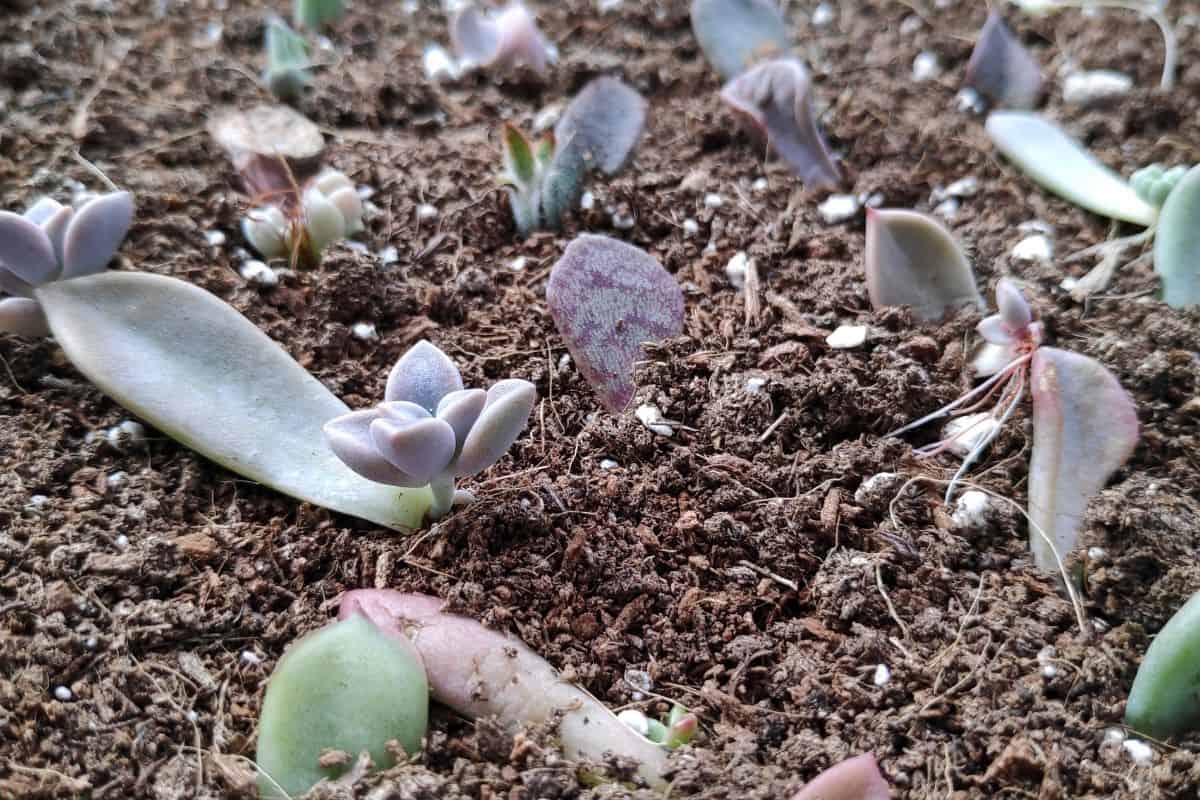
This question gets asked a lot and the answer is "never".
The baby plant gets nutrients and water from the mother leaf. You can watch the leaf slowly yellow and shrink over the course of a couple months. Eventually, it will shrivel up completely and fall off.
That's what you want to happen. Let the baby suck every last bit of nutrients it can.
Besides, when you pull it off early, you risk damaging the leaves and roots.
This usually also marks a good time for your to transplant that new succulent. You usually want to wait until it's about an inch in diameter or separated from its mother before taking it out of your propagation station.
Where to Find Succulent Leaves and Cuttings
The first and most obvious answer is that you can find them in your own collection! Pruning isn't a chore for us fat plant aficionados because every leaf and stem pruned is another potential plant!
Your friends and neighbors are also good sources. Ask before taking anything, of course. Most succulent enthusiasts are equally enthusiastic about sharing their treasures.
Garden centers will often have fallen succulent leaves on the floor. I know several people that collect these as they're shopping, then ask the employee at the cash register if they can take them home. The employee almost always says yes.
Here are some places you should NOT take leaves or cuttings from: people's window planters, displays at businesses, parks, or anywhere you find wild succulents. Be considerate!
Where to Buy Succulent Leaves and Cuttings
And if all that collecting sounds laborious, there are plenty of people willing to ship you leaves and cuttings. The best part is that they're almost always dirt cheap.
The Succulent Source, a premier online nursery, sells a great variety of both leaves and cuttings for great prices.
Etsy, being an online marketplace, has more cuttings and leaves than you can shake a stick at. Seriously, it's crazy. Check it out.
Amazon, as always, has many options for those of you trying to get your money's worth out of that Prime membership. It also serves as a channel for some high-end nurseries like Fat Plants San Diego.
Check out your local nursery! They always have plants and deals that will surprise you!
How did growing those cuttings go? Where did you get your leaves? Tell us in the comments below!





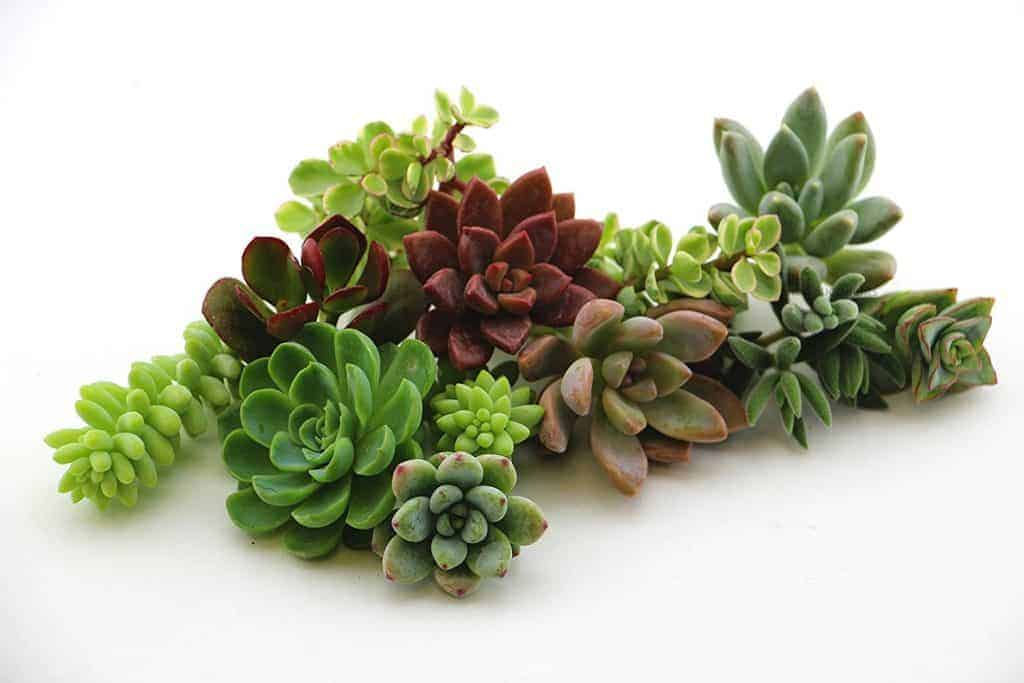
teresa
I have a few leaves that have scabbed over and have a few strings developing. Can I put them in dirt now, and any idea how long it will take to see something growing above the dirt level? I guess I'm wondering how long before I know if I am successful or not! LOL. Thanks!
Catherine
This is true it actually worked but it takes like three months for the first plant to sprout.